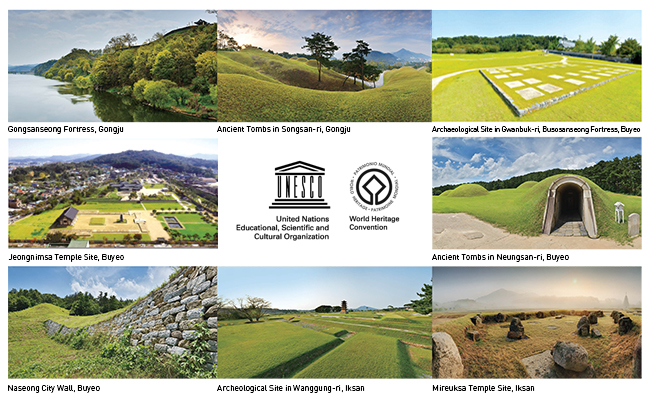
▲ World Cultural Heritage
UNESCO World Heritage Committee Held on June 28 July 8 in Bonn, Germany
The country's Baekje Historic Areas, including Gongju and Buyeo in Chungcheongnam-do and Iksan, Jeollabuk-do, will be registered on the World Heritage List. They will be the first World Heritage sites in the Province and the first ones associated with the Baekje Dynasty (18 BC - 660 AD).
Each year, the UNESCO World Heritage Committee (WHC) holds the General Assembly for the registration of cultural heritage sites and natural heritages in countries on the World Heritage List based on their applications.
The 39th General Assembly, slated to be held from June 28 through July 8 this year at the World Conference Center in Bonn, Germany, will make the final decision on the registration of the Baekje Historic Areas.
An Heejung, the Governor of Chungcheongnam-do, is attending the General Assembly this year to express his gratitude for the Committee's decision on the registration of said areas in a speech on July 4 and disclose the Provincial Government's plan for their preservation and management.
On May 4, the Cultural Heritage Administration of Korea (CHA) and the Chungcheongnam-do Provincial Government disclosed that the International Council on Monuments and Sites (ICOMOS) submitted to UNESCO its evaluation report recommending for inscription of the Baekje Historic Areas on the World Heritage List.
The Baekje Historic Areas include eight sites: Gongsanseong Fortress and Ancient Tombs in Songsan-ri, Gongju; Archaeological Site in Gwanbuk-ri, Busosanseong Fortress, Ancient Tombs in Neungsan-ri, Jeongnimsa Temple Site, and Outer City Wall, Buyeo; and Archeological Site in Wanggung-ri and Mireuksa Temple Site, Iksan.
The Baekje Dynasty designated Wirye (present-day Seoul) as its first capital in 18 BC and relocated the capital twice to Ungjin (present-day Gongju) in 475 CE, and then to Sabi (present-day Buyeo) in 538 CE during its 678 years of existence.
According to the ICOMOS report, the Baekje Historic Areas meet two of the ten criteria for registration as World Heritage sites: exhibits an important interchange of human values, over a span of time or within a cultural area of the world, on developments in architecture or technology, monumental arts, town planning, or landscape design, and; "to bear unique or at least exceptional testimony to a cultural tradition or to a civilization."
Specifically, the Baekje Historic Areas had their value as World Heritage sites recognized based on the following factors: display of development in architectural skills and spread of Buddhism as accomplished through exchanges with China, Japan, and other kingdoms on the Korean Peninsula, and; their being heritages displaying the history, view of future life after death, religion, architectural skills, and artistic sense of the people of Baekje through the selection of the location of the capital, Buddhist temples, infrastructure of castle walls and buildings, tombs, and stone pagodas.
Said areas also received high marks for their good preservation status, thanks to an effective legal system for the protection and systematic management of historic heritage sites.
ICOMOS is a private body carrying out review and consulting for UNESCO WHC. It is customary for WHC to accept ICOMOS's evaluation results as they are.
Ten historic sites including the Gyeongju Historic Areas and a natural heritage site on Jeju Island have been submitted for registration on the World Heritage List. Upon confirmation of the registration, the Baekje Historic Areas will become the country's first World Heritage sites associated with the Baekje Dynasty, bringing the total number of Korea's registered World Heritage sites to 12.
Chairman Song, Suk-doo of the Baekje Historic Areas Conservation and Management Foundation (concurrently serving as the Lieutenant Governor for Administrative Affairs of Chungcheongnam-do) said, ※As a descendant of Baekje, I believe that said registration will provide me with a new opportunity to shed light on the historic value of the Baekje Period, and I sincerely hope that it will serve as a momentum for sustainable development for local residents, young and old alike.
The Baekje Historic Areas Conservation and Management Foundation is an independent foundation established through joint investment by the offices of Chungcheongnam-do, Jeollabuk-do, Gongju-si, Iksan-si, and Buyeo-gun, which have jurisdiction over said areas. It is based in Daejeon, where CHA is also located.
Exploration of a trail for studying Baekje history
In conjunction with said registration, the Chungcheongnam-do Provincial Government plans to develop a one-night, two-day course connecting the three cities of Buyeo, Gongju, and Iksan as a leading tourism product of the Province.
Under the plan, the Province will improve the current Baekje-related tourism content and programs so as to foster the Baekje Historic Areas as popular tourist attractions. Systematic conservation and maintenance of the sites will be promoted, too.
The office will concretize the short- and long-term plans including the development of a trail for studying Baekje history and production of relevant tourist maps with the aim of enhancing visitors' convenience.
It is working on the production of the Baekje History Tourist Map by the end of July, as said registration is expected to increase the number of people visiting the Baekje Historic Areas particularly during the summer holidays.
The office will also set up plans for the restoration and overhaul of Baekje historic sites and operation of the UNESCO task force team.
